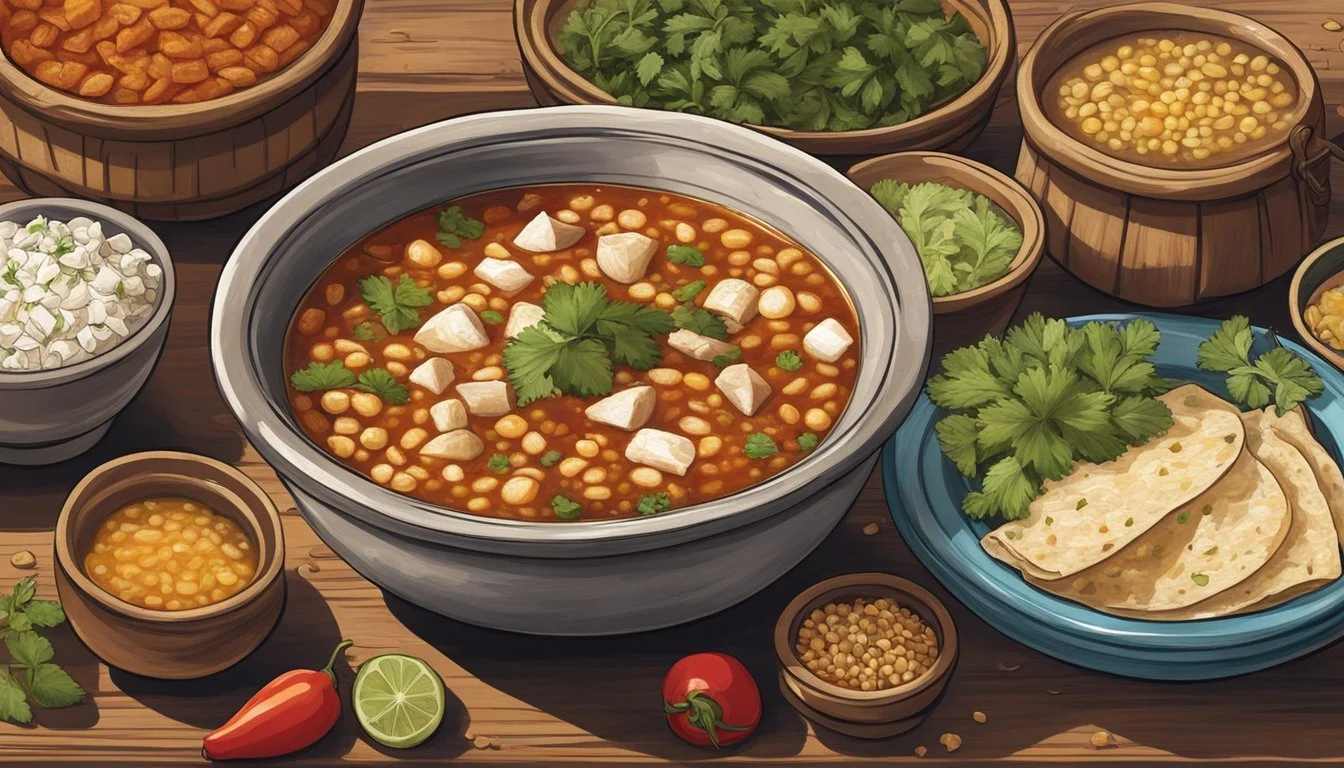Menudo
The Mexican Hangover Soup Exploring a Hominy Tradition
Menudo, a traditional Mexican soup known for its rich flavors and hominy, holds a revered place in culinary culture as a reputed hangover remedy. This hearty dish blends tripe, which is the stomach lining of a cow, with a spiced broth and hominy—a type of processed corn—to create a deeply satisfying stew. Often consumed in the early hours of the morning or late at night, menudo's popularity soars especially after festive occasions, where it is sought by those looking to soothe the aftermath of overindulgence.
This robust soup is not only a staple for personal recovery but also serves as a symbol of communal gathering and comfort. It shines as a centerpiece during family events and local celebrations, where each cook might add personal touches to the time-honored recipe. Though recipes vary by region and family tradition, the core ingredients of menudo remain consistent, ensuring its distinctive taste is enjoyed by many generations.
Menudo's effectiveness for hangovers, while not scientifically proven, is strongly supported by anecdotal evidence. Patrons swear by its restorative properties, attributing the soup's capabilities to the nutrients within the broth and the proteins in the tripe. Whether it's the warm spices or the rich, gelatinous texture that works the magic, menudo persists as a comforting remedy and continues to be a cultural icon within Mexican cuisine.
Historical Significance and Regional Variations
Menudo has a rich historical tapestry that is deeply interwoven with Mexican culture and traditions. This section explores its origins and the distinctive regional takes on this beloved soup.
The Origins of Menudo
The genesis of Menudo stretches back to the pre-Columbian era, where this dish began as a means of ensuring nothing from the slaughtered livestock went to waste. Over the centuries, Menudo solidified its status within Mexican celebrations, particularly during Christmas and other festive occasions. Its preparation and consumption have come to symbolize not only efficient resource use but also unity and warmth within the community.
Menudo Across Mexican States
Each Mexican state brings its own flair to Menudo, creating a diverse range of tastes and ingredients.
Sinaloa: Here, Menudo is prepared in a "blanco" or white version, where red pepper is excluded to give the soup a distinctive light color and a milder taste.
Northern Mexico: Menudo is typically accompanied by hominy, enhancing its texture and flavor.
Central Mexico: Often referred to as "panza" or "pancita," this region's take on Menudo includes a blend of local spices for an earthy base.
Yucatan Peninsula: Known as "mondongo," Menudo here is characterized by a distinctive sour note, usually achieved by adding vinegar.
The common thread across all variations is the use of tripe, which has been a Mexican cuisine staple for generations. Each regional adaptation showcases the diversity of Mexico's culinary culture.
Menudo's Role in Mexican Cuisine
Menudo stands as a quintessential dish in Mexican cuisine, deeply entwined with cultural traditions and often regarded as a remedy for hangovers.
Cultural Significance
In Mexican culture, menudo is more than just a soup; it serves as a symbol of heritage and collective identity. The dish has historical roots in indigenous communities and has evolved through centuries of cultural exchange. It is widely recognized for its hearty flavor profile, with a base of beef tripe and a red chili pepper broth, often seasoned with Mexican oregano and garnished with lime, onions, (What wine goes well with onions?) and chopped cilantro. This concoction is not only a culinary staple, it carries an esteemed place as a comfort food that knits communities and families together.
Common Occasions for Menudo
Menudo is traditionally consumed during family gatherings, festivities, and notably, the day after large celebrations to address hangovers. The soup is commonly associated with morning repasts after a night of revelry, earning it the nickname "the Mexican hangover soup." It's also a popular weekend breakfast served in various regions of Mexico, each with its unique twist on the recipe. In some households, preparing menudo is a communal activity that fosters bonding and shared responsibility, with posole sometimes served as an alternative variation of this nurturing meal.
Preparing the Ingredients
Proper preparation of ingredients is crucial in Menudo to ensure a rich flavor and satisfying texture. This section details the specific steps to select and prepare the primary elements of this traditional soup.
Selecting the Right Cut of Tripe
For Menudo, honeycomb tripe is the ideal choice due to its texture and flavor. This type of beef tripe refers to the second stomach of a cow. When selecting tripe, it should have a pale white color with a characteristic honeycomb pattern. Menudo traditionally sources its protein from offal, so it is essential the tripe is fresh and properly cleaned. Preparing the tripe involves:
Rinsing: Tripe must be rinsed thoroughly under cold water to remove any impurities.
Trimming: Excess fat should be trimmed off to ensure a leaner protein content and better texture.
Cutting: The tripe should be cut into uniform, bite-sized pieces to allow for even cooking.
Boiling: Before incorporating it into the broth, boiling the tripe is recommended to soften its texture.
The Importance of Hominy
Hominy, dried maize kernels that have been treated with an alkali, is a key carbohydrate source in Menudo, providing both texture and sustenance. Traditionally, white hominy is used, which adds a mild, earthy flavor to the soup. There are two main types of hominy available:
Canned hominy: Convenient and ready to use, canned hominy can be added directly to the soup, usually without additional preparation.
Dried hominy: Requires soaking and cooking prior to being added to Menudo. It typically has a firmer texture and a more pronounced corn flavor.
In terms of calories, hominy is a nutritious addition to the soup, contributing energy while being low in fat. To incorporate hominy into Menudo:
If using canned hominy, drain and rinse the kernels before adding them to the pot to remove any excess sodium.
For dried hominy, soak the kernels overnight, then rinse and boil until they are tender and have burst open.
The Cooking Process
The cooking process of menudo centers around meticulous cleaning and slow simmering. A patient approach is vital to achieve the signature rich flavors and tender texture characteristic of this traditional Mexican dish.
Cleaning and Preparing the Tripe
To ensure the tripe is clean and free from any unwanted aromas, one begins with a thorough wash. They rinse the tripe under cold water and use a combination of salt and vinegar, scrubbing it diligently to remove impurities. After scrubbing, they rinse the tripe several times until the water runs clear. The clean tripe is then cut into bite-sized pieces, making it ready for the pot.
Simmering for Flavor and Tenderness
Once the tripe is prepared, it is placed into a large pot along with other ingredients such as cow's feet or marrow bones, adding depth to the broth. The pot is then filled with enough water to cover the contents completely. The cook brings the mixture to a boil and reduces it to a simmer.
Simmering: This process should be maintained for approximately 2-3 hours, which allows the tripe to become tender but firm to the bite.
Cook Time: Cooking times can vary based on the ingredients and preparation methods used, but on average, the total time to make menudo ranges between 4 to 7 hours, including preparation and cook time.
Additional Flavorings: Throughout the simmering stage, aromatics like garlic, onion, and herbs are added to infuse the broth with layers of flavor.
Remember, patience is key — it is the extended simmering that melds flavors together and softens the tripe for a soothing and hearty bowl of menudo.
Enhancing the Broth
A truly satisfying bowl of Menudo starts with a deeply flavorful and aromatic broth. By concentrating on creating a rich base and using specific peppers, one can elevate the soup from a simple dish to an extraordinary experience.
Creating a Rich and Aromatic Base
To build a rich and aromatic base, onions and garlic are fundamental. They are sautéed until golden to unlock their flavors, which serve as the foundation of the broth. The use of beef bones and marrow bones contributes to the complexity and body of the broth. Simmering these components slowly and patiently allows the full range of aromas to infuse the liquid, forming an irresistible aroma that is the signature of a well-made Menudo.
Essentials for the Broth Base:
Sauté onions and garlic until golden.
Add beef bones and marrow bones for depth of flavor.
Simmer to bring out the aroma and richness of the broth.
Incorporate an array of spices to enhance complexity.
Using Guajillo Peppers
Guajillo chiles are pivotal in giving Menudo its distinctive taste and color. Their earthy and slightly sweet flavor profile complements the broth without overpowering it. The preparation involves soaking the guajillo peppers to soften them, then blending until smooth, creating a vibrant guajillo sauce. This sauce is then strained and incorporated into the broth, where it disperses its flavor and contributes an appealing reddish hue.
Incorporating Guajillo Chiles:
Soak guajillo peppers to soften.
Blend with water to create a smooth guajillo sauce.
Strain and add to the broth for flavor and color.
Seasoning and Spices
The right blend of seasoning and spices is crucial in Menudo, transforming it into a flavorful and hearty dish that can cater to a variety of tastes.
Balancing Flavors with Authentic Spices
Ground cumin and oregano are central to achieving the distinctive, earthy flavor profile of Menudo. Ground cumin contributes its warm and slightly bitter essence, while oregano offers a hint of sharpness and mint, balancing the robustness of the tripe and hominy. Proper seasoning with salt and pepper is essential, ensuring that all the flavors of the Menudo are enhanced and not overwhelmed.
Garnishing for Enhanced Taste and Texture
To elevate the Menudo's taste profile and add layers of texture, garnishes play a key role. Chopped onion and cilantro are traditionally sprinkled on top of the Menudo before serving, providing a crisp contrast to the tenderness of the tripe. Freshly squeezed lime wedges add a bright zing that cuts through the richness, enhancing both flavor and texture.
Accompaniments and Serving Suggestions
Menudo, a rich and hearty Mexican soup known for its hangover-curing properties, pairs well with an array of side dishes and beverages that enhance its flavors and textures.
Side Dishes
Tostadas: Crispy fried tortillas, often loaded with beans, cheese, and salsa. They offer a crunchy contrast to the soup's texture.
Ingredients: Tortillas, Preparation - Fry until golden and crispy
Ingredients: Beans, Preparation - Spread on top of the tostadas
Ingredients: Cheese, Preparation - Sprinkle over beans
Ingredients: Salsa, Preparation - Dollop on top or serve on the side
Warm Corn Tortillas: A staple in Mexican cuisine, providing a soft and warm complement to the savory soup.
French Roll: Often served on the side, it's ideal for dipping into the broth and absorbing the rich flavors.
In addition to these sides, a selection of toppings such as chopped onions, cilantro, and a squeeze of lime juice is frequently offered to allow diners to customize their bowl of Menudo.
Pairing with Beverages
Lime: A wedge of lime is typically served with Menudo, and its juice can be squeezed into the soup to add a bright, tangy flavor.
Traditional Beverages: Warm beverages such as café de olla (a spiced Mexican coffee) or atole (a corn masa drink) can be served to complement the robustness of the soup.
Serving Menudo with the right accompaniments not only balances the flavors but also enhances the overall dining experience, providing a variety of textures and taste sensations.
Menudo as a Hangover Cure
Menudo has long been touted in Mexican culture as a remedy for the aftermath of a night out drinking. Commonly referred to in Spanish as "menudo para los crudos," which means "menudo for hangovers," it is a traditional Mexican soup believed to alleviate the symptoms of a hangover. The stomach lining of a cow, known as tripe, is the key ingredient in this hearty stew, alongside hominy, and it's rich in spices and flavors that vary by region.
Composition:
Tripe: The main ingredient believed to absorb stomach acids.
Hominy: Adds texture and sustains the body with carbohydrates.
Broth: Spicy and aromatic, often thought to replenish lost electrolytes.
Theory Behind the Cure:
Tripe is rich in nutrients that aid in digestion and supposedly soak up excess alcohol in the system.
The hot, spicy broth is believed to stimulate the senses and help sweat out toxins.
A combination of spices and ingredients like onion, cilantro, and lime is thought to rejuvenate and stimulate recovery.
Cultural Context:
Popular in Mexican households, especially after celebrations involving alcohol.
Anecdotal evidence supports its status as a go-to hangover food.
Shared across generations, reinforcing its place in culinary tradition and hangover lore.
Despite the lack of scientific evidence to conclusively prove menudo as a hangover cure, traditional wisdom and widespread belief in its restorative properties make it a comforting choice for many seeking to ease their "crudo."
Health Benefits and Nutritional Information
Menudo, a traditional Mexican soup acclaimed for its comforting qualities, especially after a night of excess, is not only rich in flavor but also offers a variety of nutritional benefits. This section dives into the specifics of what makes menudo a healthy option, including its nutritional content and the digestive benefits of collagen contained within.
Analyzing the Nutritional Content of Menudo
Menudo's primary ingredients contribute to its nutritional profile, which includes an array of vitamins and minerals essential for maintaining health. A typical bowl of menudo rojo is known for its provision of iron, vitamin B12, and zinc. These nutrients are crucial for preventing anemia and supporting immune health.
Nutritional Facts per Standard Bowl:
Calories: Low
Protein: Present
Cholesterol: Variable (depends on the cut of meat used)
Saturated Fat: Low
Fiber: Present (due to hominy)
Vitamin C: Depends on ingredients added (like lime)
Calcium: Depends on ingredients added
Iron: High
Potassium: Present
Menudo is also typically low in saturated fat and calories, making it a favorable dish for weight management. The protein in menudo, stemming from the meat used, is vital for muscle repair and growth. Moreover, hominy, a processed form of corn kernels, adds a hint of fiber to the soup, contributing to the digestive health of consumers.
Understanding Collagen and Digestive Health
The presence of collagen in menudo stems from the use of tripe, which is the edible lining of a cow's stomach. Collagen is a key protein that is touted for its benefits to joint and skin health. In the digestive system, collagen has been observed to support the integrity and healing of the gut lining.
Here's a breakdown of collagen's role:
Collagen: Offers support for digestive tract tissues; can aid in healing and soothing the gut lining.
May improve nutrient absorption due to its role in maintaining a healthy gut barrier.
Menudo, with its high collagen content, can be seen as a natural aid for digestive wellness. Serving menudo with lime juice can further enhance its health properties, as vitamin C is known to boost collagen synthesis within the body. The fortification of gut health, combined with a robust blend of nutrients, makes menudo an admirable choice for those looking to indulge in a tasty dish with healthful undertones.
Alternative Variations and Dietary Adjustments
Menudo, a traditional Mexican soup, can be tailored to fit a variety of dietary preferences. This section explores vegetarian and vegan versions of Menudo as well as low-sodium and low-fat adaptations that maintain the essence of the dish while catering to health-conscious consumers.
Vegetarian and Vegan Versions
For those adhering to vegetarian or vegan diets, replacing the beef tripe with hearty vegetables like mushrooms or jackfruit can emulate the texture of the traditional ingredients. They should incorporate vegetable broth instead of beef broth to keep the dish plant-based. Hominy remains a staple in these versions for its robust, satisfying quality.
Low-Sodium and Low-Fat Variations
To reduce sodium content, chefs may use low-sodium broth and limit added salt. White Menudo is often seen as a low-fat variation, focusing on clearer broth without the use of red chili sauce which typically contains added oil. Incorporating lean cuts of meat can also lessen the fat content without sacrificing flavor.
Conclusion
In the realm of comfort foods, Menudo stands out as a traditional Mexican stew that offers more than just warmth and rich flavors. Traditionally made with beef tripe and hominy, accented with a blend of robust spices, it is a dish deeply woven into Mexico's culinary fabric. Often served on special occasions and weekend mornings, it brings families together, embodying the essence of communal dining.
Ingredients: Simplicity and patience are key in crafting the authentic Menudo experience. The dish requires a harmonious blend of:
Beef tripe
Hominy
Chili peppers
Garlic
Onions
Oregano
Hominy
Cooking Process: The preparation involves thorough cleaning and simmering of the tripe, ensuring tenderness, while hominy adds a satisfying texture contrast. A medley of spices imbues the soup with its characteristic flavor and aroma.
In many parts of Mexico, Menudo is not only a beloved meal but also revered as a remedy for the aftermath of revelry, namely hangovers. While scientific validation of this claim is sparse, countless generations can testify to the rejuvenating effect of a hot bowl of this comforting stew.
This dish embodies the essence of Mexican cuisine, capturing the hearts and palates of those who appreciate a meal that nourishes and revives. Menudo's endurance in the collective culinary heritage of Mexico is a testament to its significance beyond being just food, standing as a cultural icon and a source of pride.







